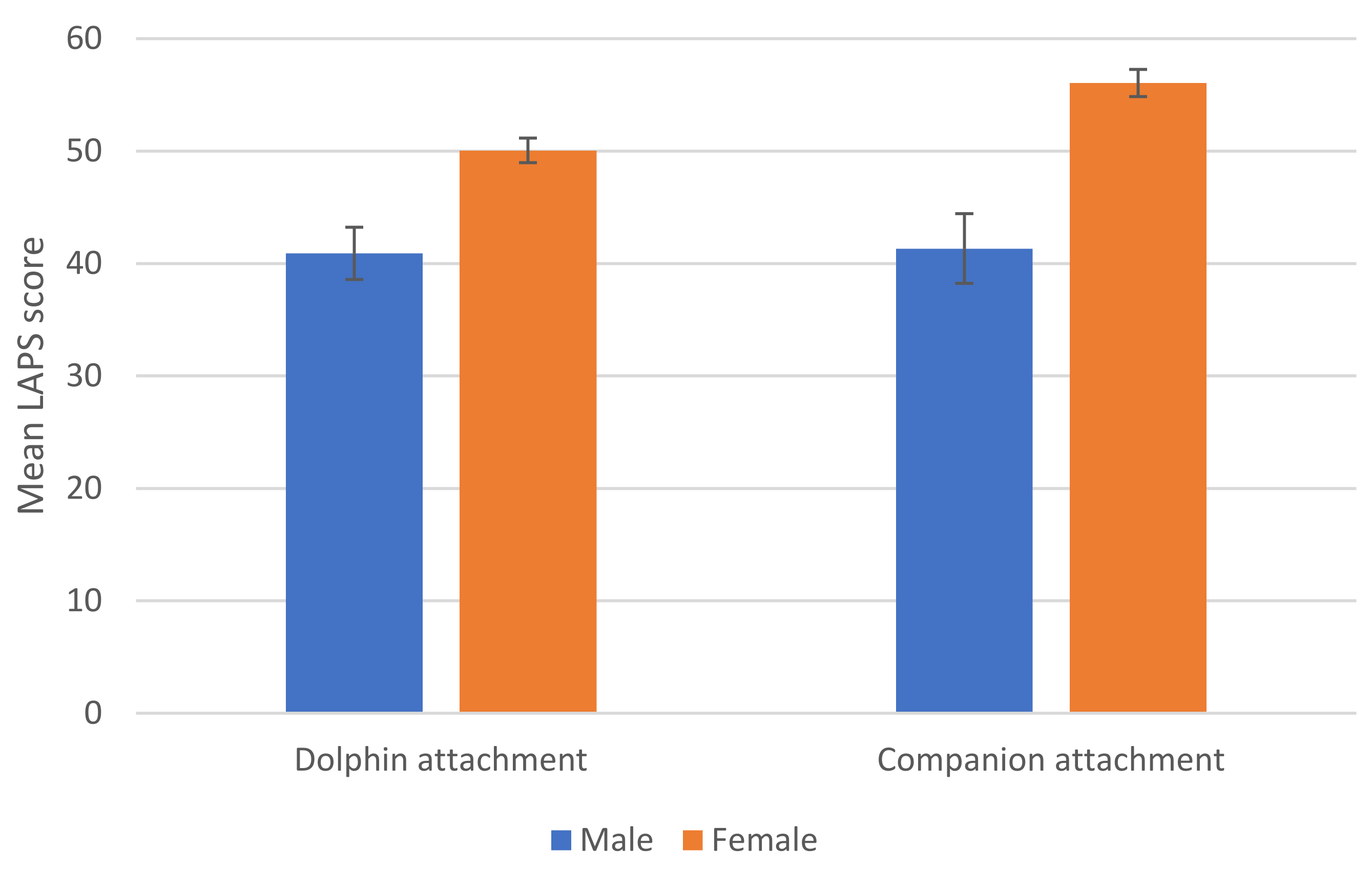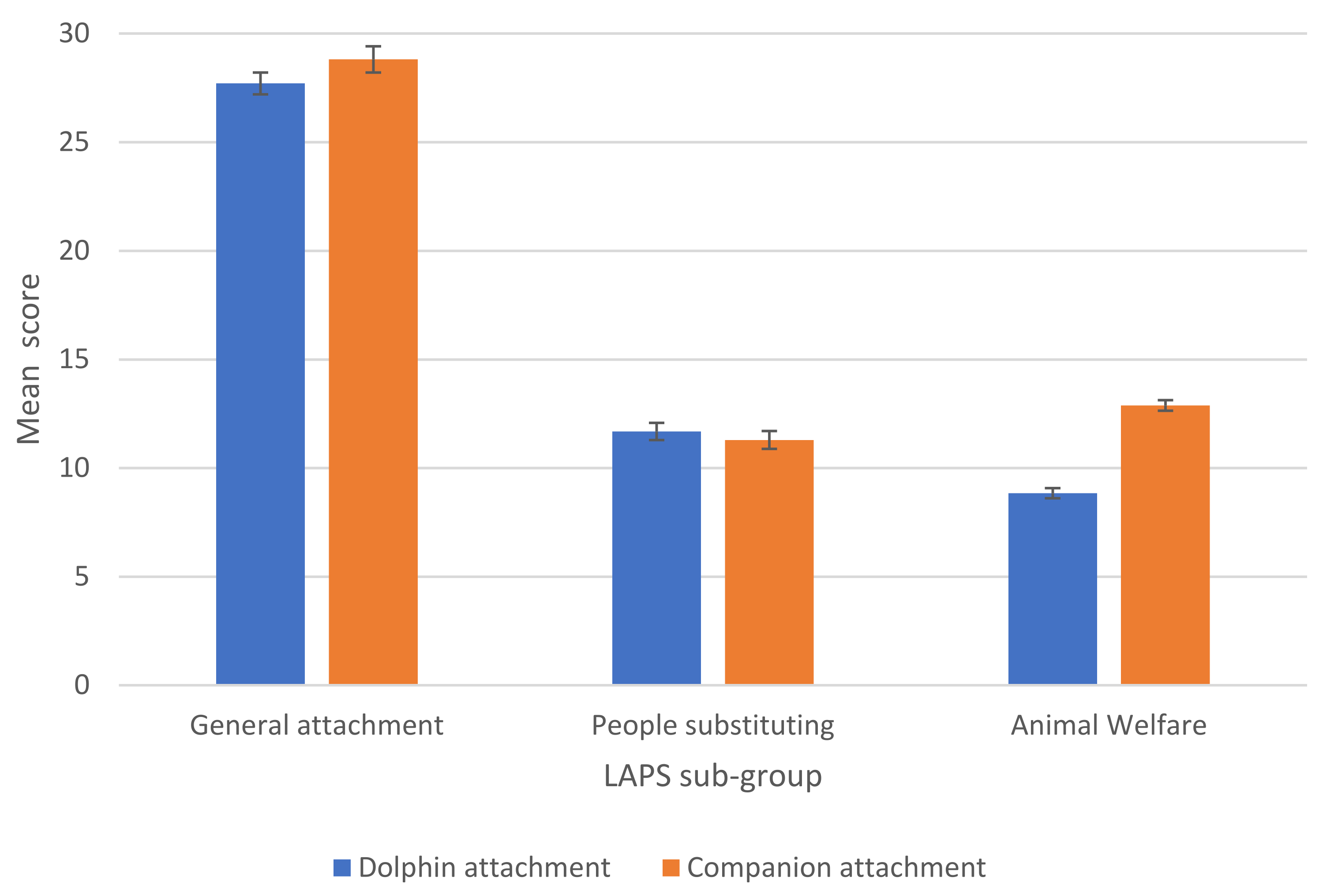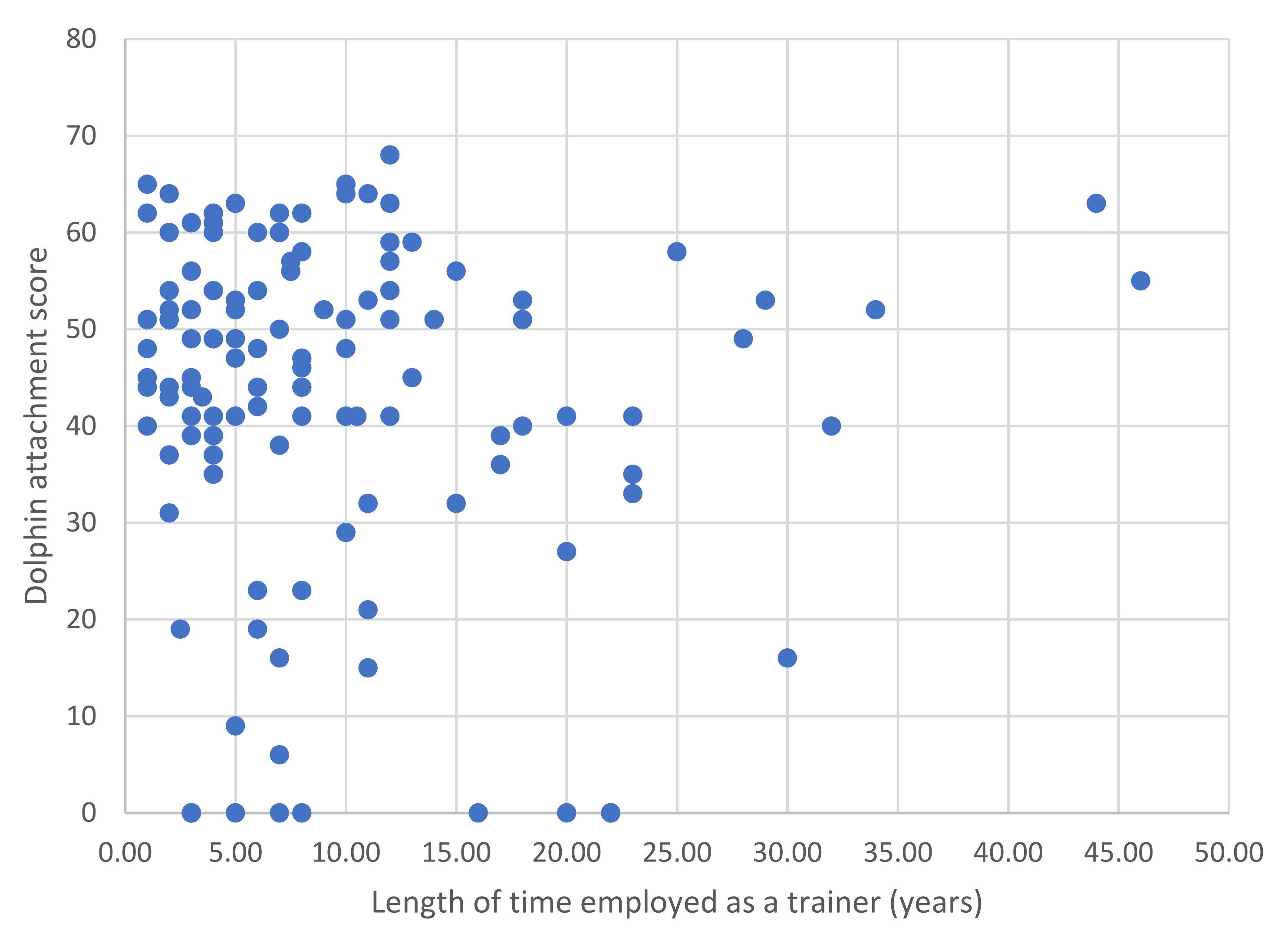Members of the Pod: Do Marine Mammal Trainers Perceive a Bond with the Animals They Care For?
Abstract
:1. Introduction
2. Materials and Methods
2.1. Survey Design
2.2. Data Collection
2.3. Data Analysis
3. Results
3.1. Respondents
3.2. Comparisons and Multiple Regression
4. Discussion
Author Contributions
Funding
Institutional Review Board Statement
Data Availability Statement
Acknowledgments
Conflicts of Interest
References
- Martin, R.A.; Melfi, V. A Comparison of Zoo Animal Behavior in the Presence of Familiar and Unfamiliar People. J. Appl. Anim. Welf. Sci. 2016, 19, 234–244. [Google Scholar] [CrossRef]
- Hinde, R.A. On describing relationships. J. Child Psychol. Psychiatry 1976, 17, 1–19. [Google Scholar] [CrossRef] [PubMed]
- Hosey, G. A preliminary model of human–animal relationships in the zoo. Appl. Anim. Behav. Sci. 2008, 109, 105–127. [Google Scholar] [CrossRef] [Green Version]
- Carlstead, K. A comparative approach to the study of Keeper-Animal Relationships in the zoo. Zoo Biol. 2009, 28, 589–608. [Google Scholar] [CrossRef]
- Ward, S.J.; Melfi, V. Keeper-Animal Interactions: Differences between the Behaviour of Zoo Animals Affect Stockmanship. PLoS ONE 2015, 10, e0140237. [Google Scholar] [CrossRef] [PubMed]
- Hosey, G.; Melfi, V. Human-Animal Interactions, Relationships and Bonds: A Review and Analysis of the Literature. Int. J. Comp. Psychol. 2014, 27, 117–142. [Google Scholar] [CrossRef]
- Rose, P.E.; Scales, J.S.; Brereton, J.E. Why the “Visitor Effect” Is Complicated. Unraveling Individual Animal, Visitor Number, and Climatic Influences on Behavior, Space Use and Interactions with Keepers—A Case Study on Captive Hornbills. Front. Vet. Sci. 2020, 7, 236. [Google Scholar] [CrossRef] [PubMed]
- Patel, F.; Whitehouse-Tedd, K.; Ward, S.J. Redefining human-animal relationships: An evaluation of methods to allow their empirical measurement in zoos. Anim. Welf. 2019, 28, 247–259. [Google Scholar] [CrossRef]
- Hosey, G.; Melfi, V. Human-Animal Bonds Between Zoo Professionals and the Animals in Their Care. Zoo Biol. 2012, 31, 13–26. [Google Scholar] [CrossRef]
- Patel, F.; Wemelsfelder, F.; Ward, S.J. Using Qualitative Behaviour Assessment to Investigate Human-Animal Relationships in Zoo-Housed Giraffes (Giraffa camelopardalis). Animals 2019, 9, 381. [Google Scholar] [CrossRef] [Green Version]
- Ward, S.J.; Sherwen, S.; Clark, F.E. Advances in Applied Zoo Animal Welfare Science. J. Appl. Anim. Welf. Sci. 2018, 21 (Suppl. S1), 23–33. [Google Scholar] [CrossRef] [Green Version]
- AVMA Committee on the Human–Animal Bond. Statement on the human–animal bond. J. Am. Vet. Med. Assoc. 1998, 212, 1675. [Google Scholar]
- Russow, L.M. Ethical Implications of the Human-Animal Bond in the Labratory. ILAR J. 2002, 43, 33–37. [Google Scholar] [CrossRef] [Green Version]
- Beetz, A.; Uvnäs-Moberg, K.; Julius, H.; Kotrschal, K. Psychosocial and Psychophysiological Effects of Human-Animal Interactions: The Possible Role of Oxytocin. Front. Psychol. 2012, 3, 234. [Google Scholar] [CrossRef] [Green Version]
- Sugawara, A.; Masud, M.M.; Yokoyama, A.; Mizutani, W.; Watanuki, S.; Yanai, K.; Itoh, M.; Tashiro, M. Effects of Presence of a Familiar Pet Dog on Regional Cerebral Activity in Healthy Volunteers: A Positron Emission Tomography Study. Anthrozoös 2012, 25, 25–34. [Google Scholar] [CrossRef]
- Dilts, R.; Trompisch, N.; Bergquist, T.M. Dolphin-Assisted Therapy for Children with Special Needs: A Pilot Study. J. Creat. Ment. Health 2011, 6, 56–68. [Google Scholar] [CrossRef]
- Hosey, G.; Birke, L.; Shaw, W.S.; Melfi, V. Measuring the Strength of Human–Animal Bonds in Zoos. Anthrozoös 2018, 31, 273–281. [Google Scholar] [CrossRef]
- Melfi, V.; Skyner, L.; Birke, L.; Ward, S.J.; Shaw, W.S.; Hosey, G. Furred and feathered friends: How attached are zookeepers to the animals in their care? Zoo Biol. 2021, 41, 122–129. [Google Scholar] [CrossRef]
- Hediger, H. Man and Animal in the Zoo: Zoo Biology, 1st ed.; Routledge & Kegan Paul: London, UK, 1970. [Google Scholar]
- Birke, L.; Hosey, G.; Melfi, V. “You Can’t Really Hug a Tiger”: Zookeepers and Their Bonds with Animals. Anthrozoös 2019, 32, 597–612. [Google Scholar] [CrossRef]
- Johnson, T.P.; Garrity, T.F.; Stallones, L. Psychometric Evaluation of the Lexington Attachment to Pets Scale (Laps). Anthrozoös 1992, 5, 160–175. [Google Scholar] [CrossRef]
- Brando, S. Advances in Husbandry Training in Marine Mammals Care Programs. J. Comp. Psychol. 2010, 23, 777–791. [Google Scholar]
- World Animal Protection. Behind the Smile—The Multi-Billion Dollar Dolphin Entertainment Industry; World Animal Protection: London, UK, 2019. [Google Scholar]
- ZIMS Species Holdings. Species360 Zoological Information Management System. Available online: http://zims.species360.org/ (accessed on 30 June 2022).
- Clegg, I.L.K.; Rödel, H.G.; Cellier, M.; Vink, D.; Michaud, I.; Mercera, B.; Böye, M.; Hausberger, M.; Lemasson, A.; Delfour, F. Schedule of human-controlled periods structures bottlenose dolphin (Tursiops truncatus) behavior in their free-time. J. Comp. Psychol. 2017, 131, 214–224. [Google Scholar] [CrossRef] [PubMed]
- Clegg, I.L.K.; Rödel, H.G.; Boivin, X.; Delfour, F. Looking forward to interacting with their caretakers: Dolphins’ anticipatory behaviour indicates motivation to participate in specific events. Appl. Anim. Behav. Sci. 2018, 202, 85–93. [Google Scholar] [CrossRef]
- Brando, S.; Kooistra, N.; Hosey, G. Pre and Post Session Behaviour of Captive Bottlenose Dolphins Tursiops trun-catusinvolved in “Swim-with-Dolphin” Events. J. Zoo Aquar. Res. 2019, 7, 195–202. [Google Scholar]
- Brando, S.; Broom, D.M.; Acasuso-Rivero, C.; Clark, F. Optimal marine mammal welfare under human care: Current efforts and future directions. Behav. Processes 2018, 156, 16–36. [Google Scholar] [CrossRef]
- Brando, S. Box B4: Marine mammal training. In Zoo Animal Learning and Training; John Wiley & Sons Ltd.: Hoboken, NJ, USA, 2020; pp. 197–201. [Google Scholar]
- Chamove, A.S.; Anderson, J.R. Examining environmental enrichment. In Housing, Care and Psychological Wellbeing of Captive and Laboratory Primates; Segal, E.F., Ed.; Noyes Publications: Park Ridge, NJ, USA, 1989; pp. 183–202. [Google Scholar]
- Brando, S. Exploring choice and control opportunities applied in enrichment and training. In Proceedings of the International Conference on Environmental Enrichment, Torquay, UK, 31 May–5 June 2009. [Google Scholar]
- Snowdon, C.T.; Savage, A. Psychological well-being of captive primates: General considerations and examples from callitrichids. In Housing, Care and Psychological Wellbeing of Captive and Laboratory Primates; Segal, E.F., Ed.; Noyes Publications: Park Ridge, NJ, USA, 1989; pp. 75–88. [Google Scholar]
- Allard, S.; Bashaw, M.J. Empowering zoo animals. In Scientific Foundations of Zoos and Aquariums: Their Role in Conservation and Research; Cambridge University Press: Cambridge, MA, USA, 2019. [Google Scholar]
- Burghardt, G.M. The Genesis of Animal Play: Testing the Limits; MIT Press: Cambridge, MA, USA, 2005. [Google Scholar]
- Panksepp, J. Affective Neuroscience: The Foundations of Human and Animal Emotions; Oxford University Press: Oxford, UK, 2004. [Google Scholar]
- Vanderschuren, L.J. How the brain makes play fun. Am. J. Play 2010, 2, 315–337. [Google Scholar]
- Clegg, I.L.; Rödel, H.G.; Mercera, B.; van der Heul, S.; Schrijvers, T.; de Laender, P.; Gojceta, R.; Zimmitti, R.; Verhoeven, E.; Burger, J.; et al. Dolphins’ willingness to participate (WtP) in positive reinforcement training as a potential welfare indicator, where WtP predicts early changes in health status. Front. Psychol. 2019, 10, 2112. [Google Scholar] [CrossRef]
- Massen, J.; Sterck, E.; de Vos, H. Close social associations in animals and humans: Functions and mechanisms of friendship. Behaviour 2010, 147, 1379–1412. [Google Scholar] [CrossRef]
- Brando, S. Wild animals in entertainment. In Animal Ethics in the Age of Humans; Springer: Cham, Switzerland, 2016; pp. 295–318. [Google Scholar]
- Brando, S. Marine mammals. In Routledge Handbook of Animal Welfare; Knight, A., Phillips, C., Sparks, P., Eds.; Routledge: Abingdon, UK, 2022. [Google Scholar]
- Jisc. Online Surveys: Formerly BOS; Jisc: Bristol, UK, 2019. [Google Scholar]
- IBM Corporation. IBM SPSS Statistics Version 25, 25th ed.; IBM Corporation: Armonk, NY, USA, 2017. [Google Scholar]
- Brando, S.; Bowles, A.E.; Böye, M.; Dudzinski, K.M.; van Elk, N.; Lucke, K.; McBain, J.; Singer, R.; Wahlberg, M. Proceedings of Marine Mammal Welfare Workshops Hosted in the Netherlands and the USA in 2012. Aquat. Mamm. 2016, 42, 392–416. [Google Scholar] [CrossRef]
- Stephens, M.B.; Wilson, C.C.; Goodie, J.L.; Netting, F.E.; Olsen, C.H.; Byers, C.G. Health Perceptions and Levels of Attachment: Owners and Pets Exercising Together. J. Am. Board Fam. Med. 2012, 25, 923–926. [Google Scholar] [CrossRef] [Green Version]
- Walsh, F. Human-Animal Bonds II: The Role of Pets in Family Systems and Family Therapy. Fam. Process 2009, 48, 481–499. [Google Scholar] [CrossRef]
- Coleman, K. Caring for nonhuman primates in biomedical research facilities: Scientific, moral and emotional considerations. Am. J. Primatol. 2011, 73, 220–225. [Google Scholar] [CrossRef] [Green Version]
- Albert, C.; Luque, G.M.; Courchamp, F. The twenty most charismatic species. PLoS ONE 2018, 13, e0199149. [Google Scholar] [CrossRef] [Green Version]
- Rault, J.-L.; Waiblinger, S.; Boivin, X.; Hemsworth, P. The Power of a Positive Human–Animal Relationship for Animal Welfare. Front. Vet. Sci. 2020, 7, 590867. [Google Scholar] [CrossRef]



Publisher’s Note: MDPI stays neutral with regard to jurisdictional claims in published maps and institutional affiliations. |
© 2022 by the authors. Licensee MDPI, Basel, Switzerland. This article is an open access article distributed under the terms and conditions of the Creative Commons Attribution (CC BY) license (https://creativecommons.org/licenses/by/4.0/).
Share and Cite
Welsh, T.; Brando, S.; Hosey, G.; Ward, S.J. Members of the Pod: Do Marine Mammal Trainers Perceive a Bond with the Animals They Care For? J. Zool. Bot. Gard. 2022, 3, 409-419. https://doi.org/10.3390/jzbg3030031
Welsh T, Brando S, Hosey G, Ward SJ. Members of the Pod: Do Marine Mammal Trainers Perceive a Bond with the Animals They Care For? Journal of Zoological and Botanical Gardens. 2022; 3(3):409-419. https://doi.org/10.3390/jzbg3030031
Chicago/Turabian StyleWelsh, Thomas, Sabrina Brando, Geoff Hosey, and Samantha J. Ward. 2022. "Members of the Pod: Do Marine Mammal Trainers Perceive a Bond with the Animals They Care For?" Journal of Zoological and Botanical Gardens 3, no. 3: 409-419. https://doi.org/10.3390/jzbg3030031
APA StyleWelsh, T., Brando, S., Hosey, G., & Ward, S. J. (2022). Members of the Pod: Do Marine Mammal Trainers Perceive a Bond with the Animals They Care For? Journal of Zoological and Botanical Gardens, 3(3), 409-419. https://doi.org/10.3390/jzbg3030031







